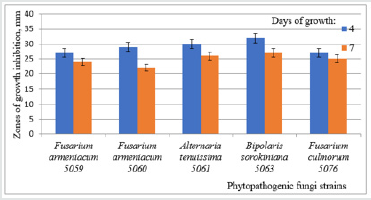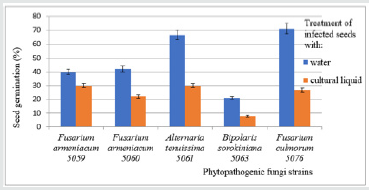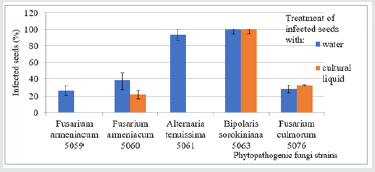Lupine Publishers- Environmental and Soil Science Journal
Abstract
Actinobacterium was isolated from the nature and shown that it has
actymotic activity against five phytopathogenic fungi that
infect cereals. The strain is identified as Streptomyces hydrogenans. It
can be the basis for the development of plant protection
products against phytopathogenic fungi.
Introduction
Chemical plant protection products cause dangerous
environmental pollution [1,2]. After getting into drinking water
sources and into agricultural products, they become a danger to
people and animals [3,4]. It is difficult now to completely abandon
chemical agents of plant protection, since a significant part of the
crop may be lost due pests, diseases and weeds. Nevertheless,
other modern plant protection means are known, which include
agrotechnical methods, selection of resistant plant kinds, the
use of biological agents [5]. These biological agents include
actinobacteria - the natural components of soil biocenoses, which
are characterized by the formation of a large number of various
antimicrobial substances, including antimycotics. It is known that
phytopathogenic fungi cause great harm to agricultural plants,
and the fight against them is of great practical importance. The
goal of our study was to search for actinobacteria, the natural
inhabitants of the soil, which are active against phytopathogenic
fungi that cause cereal diseases. Natural antimycotics, in contrast
to artificially synthesized chemical remedies, have a selectivity of
action and most of them, inhibiting the growth of phytopathogenic
fungi, harmless to most other microorganisms, plants and animals.
Under the subproject ‘Strategies for Sustainable Management of
Degraded Coastal land and Water for Enhancing Livelihood Security
of the Farming Communities’ an intervention named ‘Land Shaping’
for improving rainwater harvesting and drainage for enhancing
productivity at low lying degraded land including Tsunami affected
land at the District South 24 Parganas in the state of West Bengal’
was extended to farmer’s field termed as Intervention (treated).
The main objectives of Intervention were.
As test objects, five strains of phytopathogenic fungi isolated
from cereals in the Moscow region were used. Species identification
was performed according to morphological features and the
sequence of the ribosomal RNA gene. DNA amplification of the
ribosomal genes was performed using a set of PCR Master Mix
reagents (Thermo Scientific, USA) with fungal primers ITS1f (ctt
ggt cat tta gag gaa gta a) and NL-4 (ggt ccg tgt ttc aag g) as well
as bacterial primers 27f (aga gtt tga tcc tgg ctcag) and 1492r (tac
ggy tac ctt gtt acg act t). PCR was performed on a Thermal Cycler
2720 device (Applied Biosystems, USA) according to the program:
(1) 94°C for 1 minute, (2) 30 cycles with alternating temperature
intervals of 94°C for 1 minute, 51°C for 1 minute, 72°C for 2 minutes,
(3) 72°C for 7 minutes. The species affiliation of phytopathogenic
strains was established on the basis of a 100% coincidence with
type strains in the GenBank database: Fusarium armeniacum
5059, Fusarium armeniacum 5060, Alternaria tenuissima 5061,
Bipolaris sorokiniana 5063 and Fusarium culmorum 5076. When
searching for producers of antimycotics, an actinobacterial strain
INA 01212, identified on the basis of morphological characters as
Streptomyces hydrogenans, was sown from a potato tuber. Species
affiliation was confirmed by the structure of the 16S rRNA gene.
The sequence of the S. hydrogenans INA 01212 is deposited in
GenBank (MK238399). S. hydrogenans INA 01212 was incubated
under submerged conditions with aeration on rotary shaker with a
rotation speed of 220 rpm at a temperature 28°C. Optimal was the
nutrient medium No. 330 of the following composition (%): sucrose
- 2.1, starch - 0.85, pea flour - 1.5, NaCl - 0.5, NaNO3 - 0.5, chalk
- 0.5, tap water, pH 7.0. The highest level of antimycotic activity
manifestation is achieved on the 4th day of cultivation. The activity
of the culture fluid was established for all five phytopathogenic
strains (Figure 1).
Figure 1: Antibiotic activity of the S. hydrogenans INA 01212
cultural liquid determined by the method of diffusion into
agar against phytopathogenic fungi (diameters of growth
inhibition zones are indicated in mm).


Figure 2: The percentage of wheat germinated seeds
when grown using water (control) and cultural liquid S.
hydrogenans INA 01212.


Figure 3: The percentage of infected wheat seeds when
grown using water (control) and cultural liquid S.
hydrogenans INA 01212.


To simulate the possible interaction of actinobacteria and
phytopathogens in nature the activity of the S. hydrogenans INA
01212 culture fluid against phytopathogenic fungi on infected
wheat seeds placed on filter paper in Petri dishes under sterile
conditions was examined. Before infection with fungal spores, the
seeds were sterilized with a solution of mercuric chloride. The
culture liquid of S. hydrogenans INA 01212 was added to Petri
dishes with infected seeds; water (5 ml each) was added to the
control dishes. It is established that in these conditions, the culture
fluid reduces seed germination somewhat (Figure 2), however,
seed infection by the phytopathogens F. armeniacum 5059 and A.
tenuissima 5061 was completely absent. The strain B. sorokiniana
5063 under these experimental conditions infected almost all the
seeds, possibly due to the components of the nutrient medium that
contributed to the growth of this phytopathogen (Figure 3).
Conclusion
Actinobacterium Streptomyces hydrogenans INA 01212 exhibits
antimycotic activity in vitro against phytopathogenic fungi
Fusarium armeniacum 5059, F. armeniacum 5060, F. culmorum
5076, Alternaria tenuissima 5061 and Bipolaris sorokiniana 5063.
After seed treatment, the culture fluid somewhat suppressed seeds
germination in vitro but completely prevents their infection with
phytopathogens F. armeniacum 5059 and A. tenuissima 5061; B.
sorokiniana 5063 infects 100% of wheat seeds, presumably due to
nutrient components in cultural liquid that enhance the growth of
this fungus in the experiment.
Follow on Linkedin : https://www.linkedin.com/company/lupinepublishers
Follow on Twitter : https://twitter.com/lupine_online
No comments:
Post a Comment
Note: only a member of this blog may post a comment.